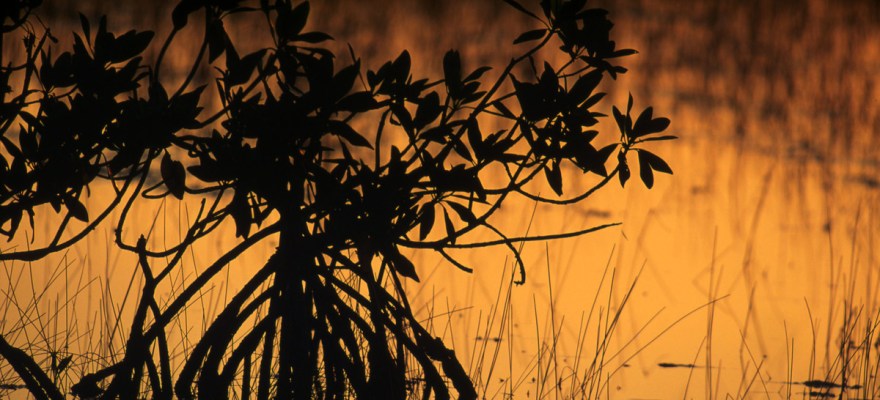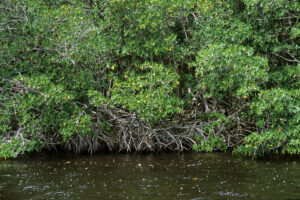
Biscayne Bay. Naples. The Gulf Coast. Miami and Key Largo. These are all places you may have visited within the sunny state of Florida. As wonderful as these areas are for beach-side and recreational activities, they’re also home to an amazing ecosystem of mangrove forests that help local wildlife thrive and be healthy. Florida mangroves are made up of tropical plants that provide a wealth of benefits for people and nature (And how cool is that!?)
In recognition of Global Mangrove Day, which is July 26, we spoke to some swamp-savvy scientists from the World Wildlife Fund (WWF) who gave us the scoop on these beautiful, tropical and ecologically important wetland forests.
“Mangroves play a vital role in the health of our planet and in addressing the climate crisis,” Karen Douthwaite, director of oceans conservation, WWF-US Oceans, said. “As climate change causes more extreme and frequent storms, mangroves become increasingly important for their benefits to people and wildlife.”
RELATED | How to Talk to Your Kids About Wildfires and Other Environmental Catastrophes

Fun Facts About Florida Mangroves
Florida isn’t the only place that has mangrove forests. They can be found in other parts of the world, too. In fact, WWF is actively working to protect, conserve, and restore mangroves in more than 20 countries.
“We aim to strengthen the protection and sustainable management of mangroves, as well as restore lost and degraded mangroves in a climate-smart way,” Douthwaite said.
And now, here are some fun facts about Florida mangroves you can use to impress your family and friends on your next trip to the Sunshine State:
- Mangroves are trees that can grow in saltwater. Saltwater is very difficult for trees to grow in, but there are about 80 species of mangroves around the world that have adapted to this unique environment. For example, red mangroves, which grow throughout the Americas including Florida, Mexico and Belize, have evolved to push salt out of their leaves to prevent dehydration.
- There are three species of mangroves in Florida and they all have “color” names. The three species are red white, and black mangroves. Red mangroves have the highest saltwater tolerance to live closest to the coast while white and black mangroves live further inland with more freshwater flow. All these species are found throughout the Caribbean and Gulf of Mexico coastlines.
- The Florida Everglades has hundreds of thousands of acres of mangroves that are helping fight against climate change. The wetlands and forest ecosystem covers more than 350,000 acres and stores about 2,000 tons of carbon dioxide, equal to the amount of carbon that would be sent into the atmosphere by burning more than 4,500 barrels of oil.
- Raccoons live here. There’s a wide variety of wildlife that call the treetops and solid land around mangroves home. Many species of tropical and subtropical birds spend time in mangroves, like pelicans, egret, ibis, spoonbill, cormorant, and anhinga. Among the birds, you might also spot orchid flowers, raccoons, and little anole lizards, while other species like the Florida panther and deer walk beneath them.
- There are many species of fish, reptiles, and mammals that live in the water around mangroves. Big species like manatees and alligators usually stay in wider channels while you might spot small gar, snapper, grouper, snook, needlefish, and shrimp closer to underwater roots.
- If you go snorkeling, thank the mangroves for the fish you see. The channels of water flowing around mangrove roots are important protected areas that act as nurseries for young fish. Fish like red drum and jacks spend their early lives hiding among mangrove roots before moving out to the open ocean or reefs where you might find them while snorkeling or fishing.
- Mangroves help protect people and wildlife from hurricanes. Mangroves grow tightly together and have above-ground roots. Combined with their ability to grow in seawater along the coastline, mangroves are an excellent natural barrier to extreme weather like storm surges and hurricanes. That means that the wildlife, people, and infrastructure—like homes and businesses—living in or behind mangroves have some natural protection against climate disasters.
- Wear bug spray! If you visit Florida mangroves, remember your bug spray and consider long sleeves and pants! Some parts of mangrove forests have standing water which can attract insects that are important to biodiversity and the health of the environment, but you might not want them to land on you.
- Look for opportunities to kayak through Florida mangroves or walk down a mangrove boardwalk. When you go somewhere that has mangroves, look for opportunities to experience moving through them. There are many boardwalks built by the National Park Service or local park services and kayak tours that are often available through local businesses. Moving through mangroves can be a very quiet and peaceful experience and great for birdwatching.
Wanna read more stuff like this? Get our newsletters packed with ideas, events, and information for parents in Staten Island.
"*" indicates required fields

